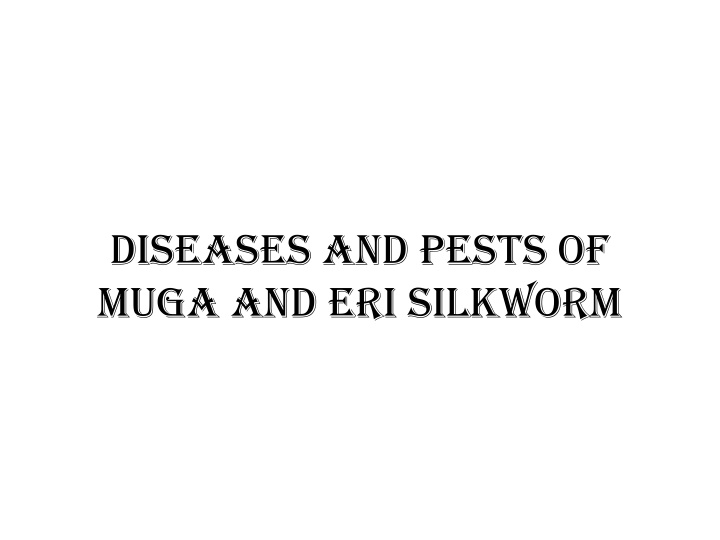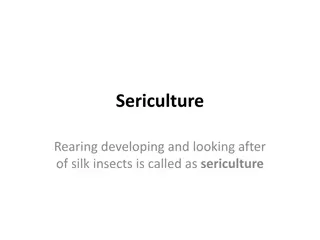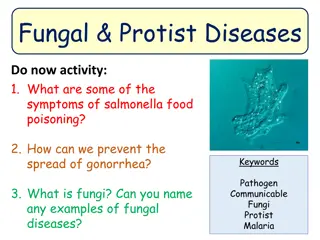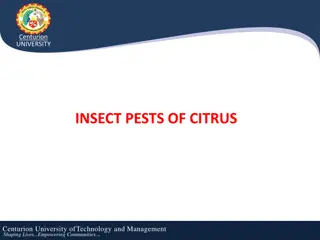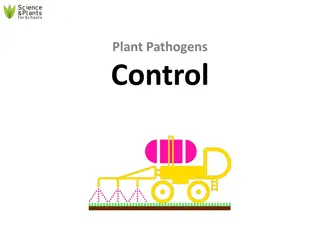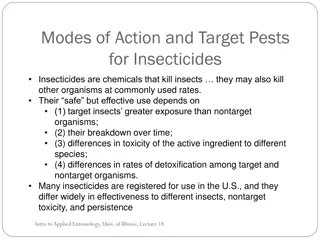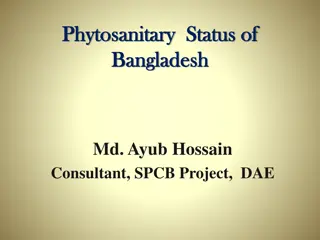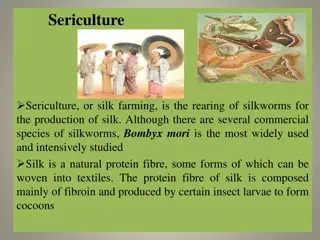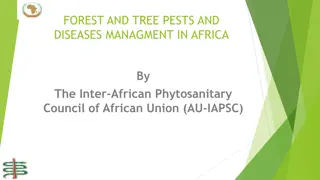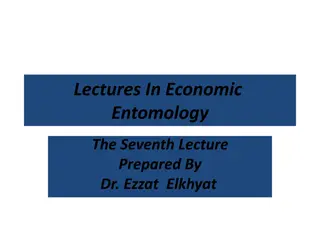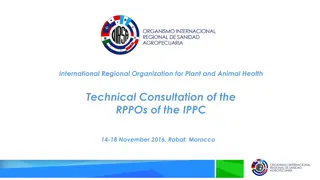Diseases and Pests of Muga and Eri Silkworm: Pebrine and Flacherie
Pebrine disease, caused by Nosema sp., affects muga silkworms with symptoms like appetite loss and irregular growth. Flacherie, caused by Pseudomonas sp., leads to lethargy and black haemolymph in larvae.
Download Presentation

Please find below an Image/Link to download the presentation.
The content on the website is provided AS IS for your information and personal use only. It may not be sold, licensed, or shared on other websites without obtaining consent from the author.If you encounter any issues during the download, it is possible that the publisher has removed the file from their server.
You are allowed to download the files provided on this website for personal or commercial use, subject to the condition that they are used lawfully. All files are the property of their respective owners.
The content on the website is provided AS IS for your information and personal use only. It may not be sold, licensed, or shared on other websites without obtaining consent from the author.
E N D
Presentation Transcript
DISEASES AND PESTS OF MUGA AND ERI SILKWORM
Diseases and pests of muga silkworm Pebrine disease: Pebrine is the most serious disease of muga silkworm caused by a protozoan of Nosema sp. It is unique in being transmitted to offspring by transovarial/ transovum means from other moths. If infection is primary, more than 50% larvae die before 3rd moult and rarely any larva goes for spinning. When healthy larvae get infected through contamination during rearing, it is called secondary infection. Secondary infection during early 4th larval stage leads to formation of flimsy cocoons, whereas larvae infected during 5th larval stage form well formed cocoons. Peak season: Throughout the year. Symptoms- Early stage of infection- The infected silkworm larvae appear normal. However, microscopic examination of silkworm larvae may indicate the presence of spores of the pathogen. Later stage of infection- The silkworm larvae loose appetite, vary in size, retarded growth, moult irregularly and the colour of the larvae become light yellowish green instead of deep green colour (normal healthy larvae). The infected late stage larvae show black dots or specks on the surface of the body and hence the disease is known as Phutuka (spotted disease in Assamese). Sources of infection: Egg stage Transovarial. Surface contamination of eggs (transovum). Contaminated grainage appliances. Larval stage Contaminated egg laying kharika. Transovarially infected larvae. Faecal materials of infected larvae. Contaminated foliage. Contaminated rearing site. Contaminated rearing appliances.
Moth stage Infected seed cocoons. Infected moth. Infected grainage appliances. Meconium and moth scales. Grainage dust. Spread of the disease: Pebrinized larvae extrude faecal material, gut juice and vomit which contaminate the rearing environment, appliances and host plant foliage. Mostly, consumption of contaminated foliage/ egg shell results in spread of the disease. Management Scientific inspection of individual mother moths for detection of pebrine during egg production. Disinfection of grainage appliances with 2% formalin before and after every grainage operation. Use microscopically tested disease free disinfected eggs only. Surface sterilization of eggs with 2% formalin for 5 minutes. Maintain hygienic condition in egg production room and rearing sites. Follow cellular method of rearing for basic stock maintenance. Disinfection of rearing appliances before use. Check the faecal materials, unequal/ lathergic/ unsettled irregular moulters periodically. If pebrine spores are detected, reject the entire infected crop.
Flacherie Flacherie; commonly known as anal protrution is a syndrome of bacterial diseases in muga silkworm caused by Pseudomonas sp. Sometimes it is caused by an ultra virus, which acts as an exciting agent followed by secondary infection of bacteria. Sudden fluctuation in temperature and humidity, bad weather, poor quality leaves with high water content are predisposing factors. Peak season: Throughout, intensive during rainy summer months (June to August). Symptoms The infected larvae become lethargic and motionless. The colour of the haemolymph turns black. Excreata looks like chain. Sealing of anal lips. Rectal protrusion. Infected larvae die within a short time. Source of infection Larvae get infected upon feeding of contaminated/ poor quality leaves of host plants. Diseased larvae, its gut juice, faecal material, body fluid. Contaminated rearing site and appliances. Spread of the disease Secondary infection of larvae due to feeding on contaminated leaves. Infected worms ooz out body fluid containing pathogen throughout the incubation period and contaminate the rearing environment. Feeding of late stage worms with very tender succulent leaves. Sudden fluctuation of temperature and humidity during rearing period.
Management Use disinfected good quality seeds of disease free zones. Orient the brushing to protect the young larvae form direct sun shine. Disinfection of rearing site with 2% formalin solution before rearing. Dust 3% slaked lime in addition to formalin in case of high incidence of the disease in the preceding year. Inspect rearing field regularly and pick out stunted/ sluggish/ irregular moulters and destroy. Destruction of diseased/ doubtful worms by burying with 5% formalin solution. Wash the hands with formalin solution at the time of transfer of worms. Maintain hygienic condition during rearing. Feed with good quality disease free leaves. Do not feed late stage worms with tender succulent leaves. Grasserie It is a major viral disease of muga silkworm caused by a baculovirus. High temperature clubbed with high humidity, poor quality host plant leaves are predisposing factors. Peak season: Throughout the year, predominant during rainy summer months of the year.
Symptoms The silkworm larvae fail to moult. The integument becomes fragile and intersegmental region becomes swollen and that is why the disease is known as Phularog (swelling disease in Assamese). The body tissues and haemolymph of the infected larvae get disintegrated into turbid white fluid and the larvae hang upside down with the anal claspers after dying. The turbid fluid contains large number of hexagonal polyhedral bodies. Source of infection Feeding of contaminated foliage. Disintegrating diseased silkworms, their body fluids. Contaminated rearing sites and appliances. Spread of the disease: The diseased silkworm larvae extrude the pathogen along with oozing of body fluid due to injury and breakage of dead and/ or diseased larvae. The body fluid and broken body parts of the larvae contaminate the foliage, rearing site and appliances. The disease spreads to healthy worms on feeding of the contaminated leaves and/ or use of contaminated appliances during rearing. Management Disinfection of rearing site with 2% formalin solution before rearing. Dust 3% slaked lime in addition to usual disinfection in case of high incidence of disease in preceding rearing. Pick out growth retarded/ lethargic/ irregular moulters and destroy. Ensure destruction of diseased/ doubtful worms by burning or burying with 5% formalin solution. Ensure proper hygiene during rearing. Use certified disinfected disease free layings only. Ensure rearing on good quality leaves. Mascardine Mascardine is one of the major diseases of silkworm. However, it is less prevalent in muga silkworm and occurs under certain specific environmental influence only. The disease appears at an interval of 2-3 years. The causal organism is a fungus and it is yet to be identified for muga silkworm. Low temperature with high humidity is predisposing factors. Peak season: Winter months of the year when night temperature falls down and the day temperature remains comparatively high associated with high humidity i.e. foggy weather.
Symptoms Infected larvae loose appetite and become inactive. Colour of the larvae turns pale. Gradual cease of movement within 12-18 hours of infection. The larvae hang on tree twig/ trunk and harden. The larvae die within 16-18 hours of infection. A white encrustation appears on the larval body and it covers the whole larval body within 24 hours of death. The dead larval body becomes dry, brittle and mummified. Source of infection Mummified / diseased larvae. Contaminated rearing environment. Spread of the disease The conidia/ spores of the pathogenic fungus are dispersed by wind. The conidia on contact with larval integument germinate, penetrate into the larval body and cause infection.
Management Orientation of brushing towards sun shine during winter. Disinfection of rearing site with 2% formalin solution before rearing. Dust slaked lime in the field to control humidity at the time of rearing. Dust Tasar Kit Oushad developed by CTR&TI, Ranchi on the body of the larvae at the time of transfer. Spray 0.5% sodium hydroxide solution on the worms after 24 hours of each moult as prophylactic measure. Maintain hygienic condition during rearing. Collection and destruction of dead/ diseased larvae Pickout sick or dead worms with forceps/ chopstick and put in 2% formalin solution. Bury the carcasses in a pit and cover the soil. Wash hands with formalin or dettol solution after handling dead or infected larvae. Do not allow birds, ants or poultry to eat the carcasses. Uzi fly (Exorista sorbillans) Nature of damage: It is the major pest of muga silkworm. The fly lays eggs on the integument of the worms in the dorsal and dorso-lateral side. After hatching from the eggs, the maggots of the fly penetrate into the larval body and feed on the tissues of the worms. The mature maggots come out of the larvae/ pupae and undergo pupation in the rearing field or grainage hall. The uzi infested muga silkworm dies during larval or pupal stage. Season of incidence: Prevalent throughout the year, peak during December to march.
Management Rear the silkworm under nylon mosquito net during peak infestation period (December to March), which ensures 80-90% control. During transfer of late stage worms, remove the fly eggs from the integument of the silkworm larvae with the help of forceps. Keep the rearing field clean and dust with bleaching powder during rearing. Mount uzi infested worms in separate Jali. Harvest and stifle the uzi infested cocoons on 4th and 5th day of spinning. Collect and destroy the maggot/ pupae of the fly. Burn heavily infested worms.
Apanteles (Apanteles stantoni) Nature of damage Usually infect the early stage silkworms. Apanteles lays eggs inside the body of silkworm larvae by inserting the ovipositor through the tubercles after maturation. The mature maggots form pupae in aggregation outside the body of the silkworm larvae. Season of incidence: Prevalent during summer and winter months of the year. Management Rearing of silkworm under nylon mosquito net. Keep the rearing field clean and dust with bleaching powder during rearing. Collect and destroy the maggots/ pupae of the fly along with the silkworm larvae. Spider: Attacks 1st instar worms Wasp (Vespa orientalis) It occurs during June-July to August-September months. It attacks early stage worms by lacerating and picking young age worms. It can be controlled by covering silkworm rearing by nylon nets and destroying hives. Red ants The red ants are also serious pest in many muga growing areas. It attacks 1st stage worms. The lost due to red ants are reported to be 5-10%. They can be controlled with the spray of 2% Rogor (insecticide) before 15 days of rearing or burning down their nest well before the rearing. Grass hopper: They attack the 2nd to 3rd stage worms. Lost due to grass hoppers are minimal
Diseases and pests of eri silkworm Pebrine Causal organism: Protozoan- Nosema sp. Peak season: Summer season of the year. Symptoms- At early stage of infection: The infected early stage worms do not show any morphological abnormality. Only microscopic examination of the silkworm larvae may indicate the presence of spores of the pathogen. Later stage of infection: The silkworm larvae loose appetite. Varies in size, retard in growth, moult irregularly and the colour of the larvae becomes pale. Infection: It is unique in being transmitted to offspring by trasovarial / transovum means from mother moth and this is called primary. If infection is primary, more than 50% larvae die before third moult and rarely any larva goes to spinning stage. When healthy larvae get infected through contamination during rearing, it is called secondary infection. Secondary infection during early 4th larval stage leads to formation of flimsy cocoons, where as larvae infected during 5th larval stage spun well formed cocoons. Source of infection Egg stage Transovarial. Surface contamination. contaminated grainage appliances. Larval stage Contaminated egg laying kharika. Transovarially infected larvae. Faecal matters of infected larvae. Excreta of infected larvae. Contaminated foliage. Contaminated rearing room. Contaminated rearing appliances.
Moth stage Purchase of infected seed cocoons. Infected moth. Infected grainage appliances. Meconium and moth scales. Grainage dust. Spread of disease: Perbrinized larvae excreat faecal matter, gut juice and vomit containing pathogens, which contaminate the rearing environment, appliances and foliage. Mostly, consumption of contaminated foliage or egg shell results in infection and spread of the disease. Management Follow the scientific inspection method of individual mother moth testing for detection of pebrine during egg production. Practice disinfection of grainage hall and appliances before and after every grainage operation with 2% formalin. Ensure use of microspically tested disease free disinfected eggs only. Practice surface sterilization of eggs with 2% formalin for 5 minutes. Maintain hygienic conditions in egg production room and rearing room. Practice disinfection of rearing appliances and rearing room before use. During rearing, test the faecal matters, unequal/ lethargic/ unsettled/ irregular moulters periodically. If pebrine spores are detected, reject the entire infected crop. Ensure the measures for destruction of diseased silkworm larvae/ cocoons/ moths/ eggs.
Flacherie Flacherie is a syndrome of bacterial diseases in eri silkworm. Flacherie disease is caused by an ultra virus, which is an exciting agent, followed by secondary infection of bacteria. Peak season: All seasons of the year, intensive during rainy summer months (June to August). Symptoms: Infected silkworm larvae become lethargic and motionless. The colour of the haemolymph turns black. Chain type excreta, sealing of anal lips, rectal protrusion are some of the easily detectable symptoms of the disease. Infected larvae die within short time. Infection: Feeding of contaminated/ poor quality foliage. Source of infection: Diseased larvae, its gut juice, faecal matters, body fluid and contaminated rearing site and appliances. Pre-disposing factor: Sudden fluctuation in temperature and humidity, bad weather, poor quality leaves with high water content. Spread of disease: The disease is transmitted by secondary infection of the larvae feeding on the contaminated/ poor quality leaves. Infected worms ooze out body fluid containing pathogen throughout incubation period of infection and contaminate the leaves of the rearing bed and rearing environment. The disease spreads to healthy worms on feeding of the contaminated leaves. Feeding of late stage worms with very tender succulent leaves and sudden fluctuation of temperature & humidity during rearing period also lead to outbreak of the disease.
Management Use disinfected quality seeds of disease free zone. Disinfection of rearing room before rearing with 2% formalin solution. Dusting of 0.3% slaked lime in addition to usual disinfection for rearing room and appliances in case of high incidence of the disease in preceding rearing. Inspect rearing room regularly and pick out stunted/ doubtful worms by burying with 5% formalin solution. Practice washing of hands with formalin solution at the time of handling of worms. Maintain hygienic condition during rearing. Feeding of good quality leaves, because food is major source of infection. Do not allow late stage worms to feed on succulent tender leaves.
Insect pests Unlike mulberry and muga silkworm, attack of insect pests is less in eri silkworm. However, use of nylon net in the windows & doors of the rearing room prevents uzi fly infestation in eri rearing. Usually fly pests come to the rearing room through the food plant foliage. Hence, preservation of plucked leaves in separate site also helps in checking the entry of fly pests.
